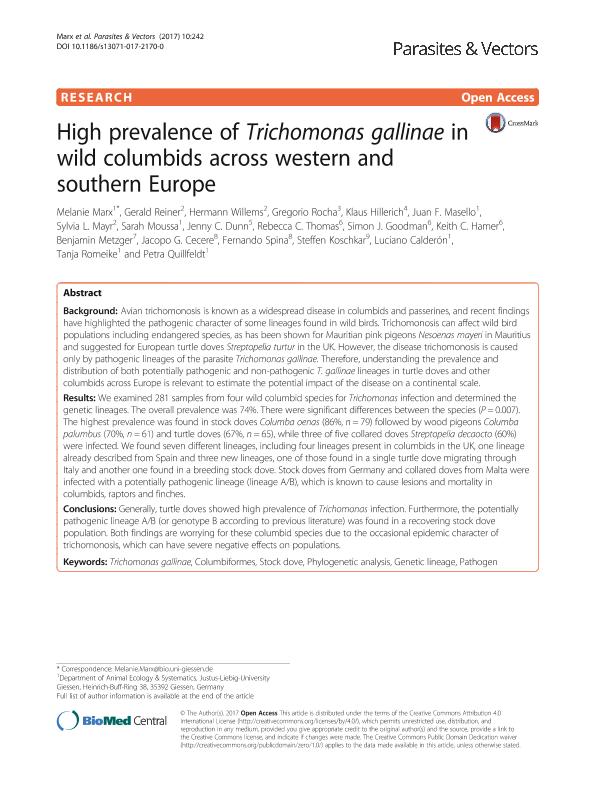Mostrar el registro sencillo del ítem
dc.contributor.author
Marx, Melanie
dc.contributor.author
Reiner, Gerald
dc.contributor.author
Willems, Hermann
dc.contributor.author
Rocha, Gregorio
dc.contributor.author
Hillerich, Klaus
dc.contributor.author
Masello, Juan Francisco

dc.contributor.author
Mayr, Sylvia L.
dc.contributor.author
Moussa, Sarah
dc.contributor.author
Dunn, Jenny C.
dc.contributor.author
Thomas, Rebecca C.
dc.contributor.author
Goodman, Simon J.
dc.contributor.author
Hamer, Keith C.
dc.contributor.author
Metzger, Benjamin
dc.contributor.author
Cecere, Jacopo G.
dc.contributor.author
Spina, Fernando
dc.contributor.author
Koschkar, Steffen
dc.contributor.author
Calderón, Pablo Luciano Sebastian

dc.contributor.author
Romeike, Tanja
dc.contributor.author
Quillfeldt, Petra
dc.date.available
2017-09-13T19:19:40Z
dc.date.issued
2017-05-18
dc.identifier.citation
Marx, Melanie; Reiner, Gerald; Willems, Hermann; Rocha, Gregorio; Hillerich, Klaus; et al.; High prevalence of Trichomonas gallinae in wild columbids across western and southern Europe; BioMed Central; Parasites and Vectors; 10; 242; 18-5-2017; 1-11
dc.identifier.issn
1756-3305
dc.identifier.uri
http://hdl.handle.net/11336/24171
dc.description.abstract
Background: Avian trichomonosis is known as a widespread disease in columbids and passerines, and recent findings have highlighted the pathogenic character of some lineages found in wild birds. Trichomonosis can affect wild bird populations including endangered species, as has been shown for Mauritian pink pigeons Nesoenas mayeri in Mauritius and suggested for European turtle doves Streptopelia turtur in the UK. However, the disease trichomonosis is caused only by pathogenic lineages of the parasite Trichomonas gallinae. Therefore, understanding the prevalence and distribution of both potentially pathogenic and non-pathogenic T. gallinae lineages in turtle doves and other columbids across Europe is relevant to estimate the potential impact of the disease on a continental scale.Results: We examined 281 samples from four wild columbid species for Trichomonas infection and determined the genetic lineages. The overall prevalence was 74%. There were significant differences between the species (P = 0.007). The highest prevalence was found in stock doves Columba oenas (86%, n = 79) followed by wood pigeons Columba palumbus (70%, n = 61) and turtle doves (67%, n = 65), while three of five collared doves Streptopelia decaocto (60%) were infected. We found seven different lineages, including four lineages present in columbids in the UK, one lineage already described from Spain and three new lineages, one of those found in a single turtle dove migrating through Italy and another one found in a breeding stock dove. Stock doves from Germany and collared doves from Malta were infected with a potentially pathogenic lineage (lineage A/B), which is known to cause lesions and mortality in columbids, raptors and finches.Conclusions: Generally, turtle doves showed high prevalence of Trichomonas infection. Furthermore, the potentially pathogenic lineage A/B (or genotype B according to previous literature) was found in a recovering stock dove population. Both findings are worrying for these columbid species due to the occasional epidemic character of trichomonosis, which can have severe negative effects on populations.
dc.format
application/pdf
dc.language.iso
eng
dc.publisher
BioMed Central

dc.rights
info:eu-repo/semantics/openAccess
dc.rights.uri
https://creativecommons.org/licenses/by/2.5/ar/
dc.subject
Trichomonas Gallinae
dc.subject
Columbiformes
dc.subject
Stock Dove
dc.subject
Phylogenetic Analysis
dc.subject
Genetic Lineage
dc.subject
Pathogen
dc.subject.classification
Bioquímica y Biología Molecular

dc.subject.classification
Ciencias Biológicas

dc.subject.classification
CIENCIAS NATURALES Y EXACTAS

dc.title
High prevalence of Trichomonas gallinae in wild columbids across western and southern Europe
dc.type
info:eu-repo/semantics/article
dc.type
info:ar-repo/semantics/artículo
dc.type
info:eu-repo/semantics/publishedVersion
dc.date.updated
2017-07-13T17:54:18Z
dc.journal.volume
10
dc.journal.number
242
dc.journal.pagination
1-11
dc.journal.pais
Reino Unido

dc.journal.ciudad
Londres
dc.description.fil
Fil: Marx, Melanie. Justus-Liebig-University. Department of Animal Ecology & Systematics,; Alemania
dc.description.fil
Fil: Reiner, Gerald. Justus-Liebig-University. Department of Clinical Veterinary Sciences; Alemania
dc.description.fil
Fil: Willems, Hermann. Justus-Liebig-University. Department of Clinical Veterinary Sciences; Alemania
dc.description.fil
Fil: Rocha, Gregorio. Universidad de Extremadura. Departamento de Ingeniería Agro-Forestal; España
dc.description.fil
Fil: Hillerich, Klaus. Röntgenstraße; Alemania
dc.description.fil
Fil: Masello, Juan Francisco. Justus-Liebig-University. Department of Animal Ecology & Systematics,; Alemania
dc.description.fil
Fil: Mayr, Sylvia L.. Justus-Liebig-University. Department of Clinical Veterinary Sciences; Alemania
dc.description.fil
Fil: Moussa, Sarah. Justus-Liebig-University. Department of Animal Ecology & Systematics,; Alemania
dc.description.fil
Fil: Dunn, Jenny C.. University of Lincoln. School of Life Sciences, ; Reino Unido
dc.description.fil
Fil: Thomas, Rebecca C.. University of Leeds. School of Biology; Reino Unido
dc.description.fil
Fil: Goodman, Simon J.. University of Leeds. School of Biology; Reino Unido
dc.description.fil
Fil: Hamer, Keith C.. University of Leeds. School of Biology; Reino Unido
dc.description.fil
Fil: Metzger, Benjamin. Birdlife Malta. Xemxija Waterfront Apartments; Malta
dc.description.fil
Fil: Cecere, Jacopo G.. Institute for Environmental Protection and Research; Alemania
dc.description.fil
Fil: Spina, Fernando. Institute for Environmental Protection and Research; Alemania
dc.description.fil
Fil: Koschkar, Steffen. Dorfstraße; Alemania
dc.description.fil
Fil: Calderón, Pablo Luciano Sebastian. Justus-Liebig-University. Department of Animal Ecology & Systematics,; Alemania. Consejo Nacional de Investigaciones Científicas y Técnicas. Centro Científico Tecnológico Conicet - Mendoza. Instituto de Biología Agrícola de Mendoza. Universidad Nacional de Cuyo. Facultad de Ciencias Agrarias. Instituto de Biología Agrícola de Mendoza; Argentina
dc.description.fil
Fil: Romeike, Tanja. Justus-Liebig-University. Department of Animal Ecology & Systematics,; Alemania
dc.description.fil
Fil: Quillfeldt, Petra. Justus-Liebig-University. Department of Animal Ecology & Systematics,; Alemania
dc.journal.title
Parasites and Vectors

dc.relation.alternativeid
info:eu-repo/semantics/altIdentifier/url/http://parasitesandvectors.biomedcentral.com/articles/10.1186/s13071-017-2170-0
dc.relation.alternativeid
info:eu-repo/semantics/altIdentifier/doi/http://dx.doi.org/10.1186/s13071-017-2170-0
Archivos asociados
